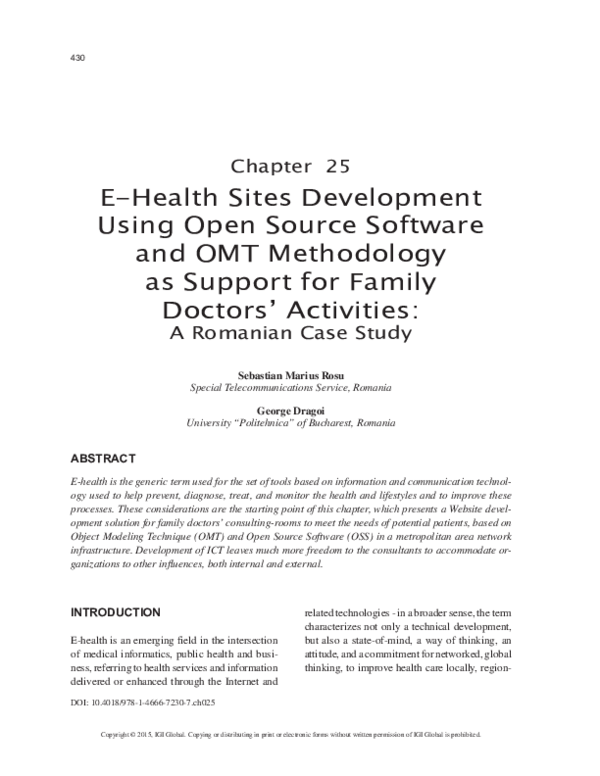Academia.edu no longer supports Internet Explorer.
To browse Academia.edu and the wider internet faster and more securely, please take a few seconds to upgrade your browser.
E-Health Sites Development Using Open Source Software and OMT Methodology as Support for Family Doctors’ Activities
E-Health Sites Development Using Open Source Software and OMT Methodology as Support for Family Doctors’ Activities
2014, Technological, Social, and Organizational Dimensions
Related Papers
International Journal of Technology and Management Research
Design and Implementation of a Web Based Health Information SystemHealth Information System aims at improving and enhancing the delivery of quality, data availability and administrative effectiveness of people’s health. Medical record has come under severe threat as a result of the manual system of medical record keeping in spite of its important functions. This system of record-keeping involves taking down patient data on pieces of paper, which are put into files and kept in cabinets. In fact, this is an improper means of documentation resulting in loss and mismatch of patient data, and time wastage. It is alsocumbersome, bulky and consumes a lot of the office space. In this paper, a complete web-based health information system is designed to solve these problems so as to enable users handle details on policies efficiently and effectively. A test of the system over various network topologies reveals that time taken to move a packet and received acknowledgment for standalone, LAN, WAN and Intranet is 3ms, 4ms, 8ms and 10ms respectively. These shor...
Wiener klinische Wochenschrift
E-health integration and interoperability based on open-source information technology2010 •
Bulletin of Electrical Engineering and Informatics
Online medical consultation: covid-19 system using software object-oriented approach2021 •
The internet has been a source of medical information, it has been used for online medical consultation (OMC). OMC is now offered by many providers internationally with diverse models and features. In OMC, consultations and treatments are available 24/7. The covid-19 pandemic across-the-board, many people unable to go to hospital or clinic because the spread of the virus. This paper tried to answer two research questions. The first one on how the OMC can help the patients during covid-19 pandemic. A literature review was conducted to answer the first research question. The second one on how to develop system in OMC related to covid-19 pandemic. The system was developed by Visual Studio 2019 using software object-oriented approach. Online expert review was conducted within 6 experts from health and academic industry to verify the model. Also, the system was validated by 11 users from heath and academic industry to confirm its usability. The statistical package for social science (SPS...
The purpose of this paper is to overcome the limited hour service availability in the current medical scenario. Saving time for both doctors and patients. Eliminating the time wasted sitting at the clinics. Good for doctors who cannot practice in clinics. In essence we are going to create a platform where people can come online and share ideas, raise discussions, issue complaints, create suggestion/reviews for doctor's services and encourage the use of e-prescriptions and anytime personalized services to patients. By eliminating the waiting time to meet the doctor we can saves both doctor's and patient's time and emergency services can be easily available.
Journal of the American Medical Informatics Association
Internet as Clinical Information System: Application Development Using the World Wide Web1995 •
International Journal of Science and Engineering Applications
Web-based Clinic Management System (CMS)INQUIRY: The Journal of Health Care Organization, Provision, and Financing
Electronic Health Object: Transforming Health Care Systems From Static to Interactive and Extensible2015 •
Electronic health records (EHRs) store health-related patient information in an electronic format, improving the quality of health care management and increasing efficiency of health care processes. However, in existing information systems, health-related records are generated, managed, and controlled by health care organizations. Patients are perceived as recipients of care and normally cannot directly interact with the system that stores their health-related records; their participation in enriching this information is not possible. Many businesses now allow customers to participate in generating information for their systems, strengthening customer relationships. This trend is supported by Web 2.0, which enables interactivity through various means, including social networks. Health care systems should be able to take advantage of this development. This article proposes a novel framework in addressing the emerging need for interactivity while preserving and extending existing electronic medical data. The framework has 3 dimensions of patient health record: personal, social, and medical dimensions. The framework is designed to empower patients, changing their roles from static recipient of health care services to dynamic and active partners in health care processes.
RELATED PAPERS
Coastal Engineering Proceedings
New Rational Model for the Current-Induced Three Dimensional Scour Beneath Submerged Pipelines2020 •
Estudios Geográficos
La inversión española en el sector energético mexicano y su proyección territorial en el marco de las políticas económicas neoliberales2007 •
Journal of Econometrics
Identification and nonparametric estimation of a transformed additively separable model2010 •
2023 •
European Journal of Anaesthesiology
Surface landmarks and anatomic relationships of sciatic nerve for anaesthetic blockade: cadaveric study2004 •

 George Dragoi
George Dragoi